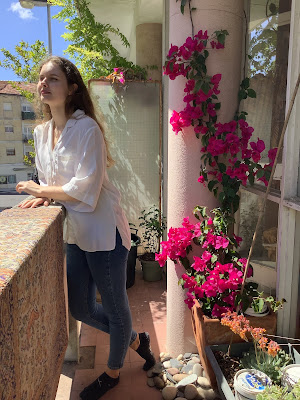It's now more than two years since I first started experimenting with micro-composts, and the results have been remarkable. Our balcony has changed from a sterile display of plants to something much more alive. All sorts of insects, spiders and worms have emerged, and the plants have benefitted greatly.
However, micro-composts are not ideal. The end product is rarely sufficiently composted to be used directly, and I have therefore resorted to a system of post-composting in order to finalize the process. The semi-composted refuse from the micro-composts is put into a large bin with soil containing earth worms.
These worms came about as a result of the micro-compost experiment. I didn't buy them, or import them. They appeared out of nowhere, and they are now an important part of the composting process.
This means that I'm having up and running worm composters on our balcony as things are right now, and I've decided to experiment more in that direction. I'm going to abandon the micro-compost system, and instead have one big bin. This bin will have a thick layer of earth, rich in earth worms. Holes for kitchen refuse can then be dug into this. When a hole is filled up, soil can be spread on top to cover it.
The bin I'm using is large enough for at least 20 days of use before I have to dig into a place I've dug a hole before. This is not long enough to complete the compost, but it's long enough to have the refuse greatly reduced in size. This means that I can heap the 20 day old refuse on top of the previous hole I dug, and then add some soil on top to cover. That previous hole will then have fresh refuse at the bottom, 20 days old refuse on the top and a thin layer of earth to cover. A new hole is thus created for fresh refuse. When it is full, the process repeats.
This means that the next time I complete a circle, I'll encounter the three layers of refuse and soil again, only 20 days older. The top refuse will have had 40 days total to compost, which should be enough for it to be used. The 20 day old refuse can then be tossed upon the previous hole, and the process repeats. From that time on, I will constantly encounter three layers of refuse where the top layer is old enough to be used as compost for my plants.
This may sound elaborate and rigid, but it is in fact both straight forward and flexible. When there's a lot of refuse, I can toss some or all of it directly onto the worm composter. Large leaves and such can in this way be used as a natural cover while simultaneously saving me some effort. The top cover can be either soil or leaves. As long as it covers the refuse, it serves its purpose.
My guess is that this new system will be more efficient than the system of micro-composts that I started out with. It will also be more convenient; so much so that it will beat any alternative, including the usual way of tossing kitchen refuse into the garbage. This is because a trip out on the balcony is quicker and easier than to fill a garbage bin with refuse and then take it out to the trash container outside.
If I'm right in this, I will not only have a free supply of fresh earth for my plants, but I will also have a quick and convenient way to get rid of kitchen refuse. If so, I will have rediscovered a convenience that has been lost in our mistaken belief that throwing refuse into the garbage is the quickest and easiest way to deal with this type of waste.
 |
| Balcony with flowers |
No comments:
Post a Comment